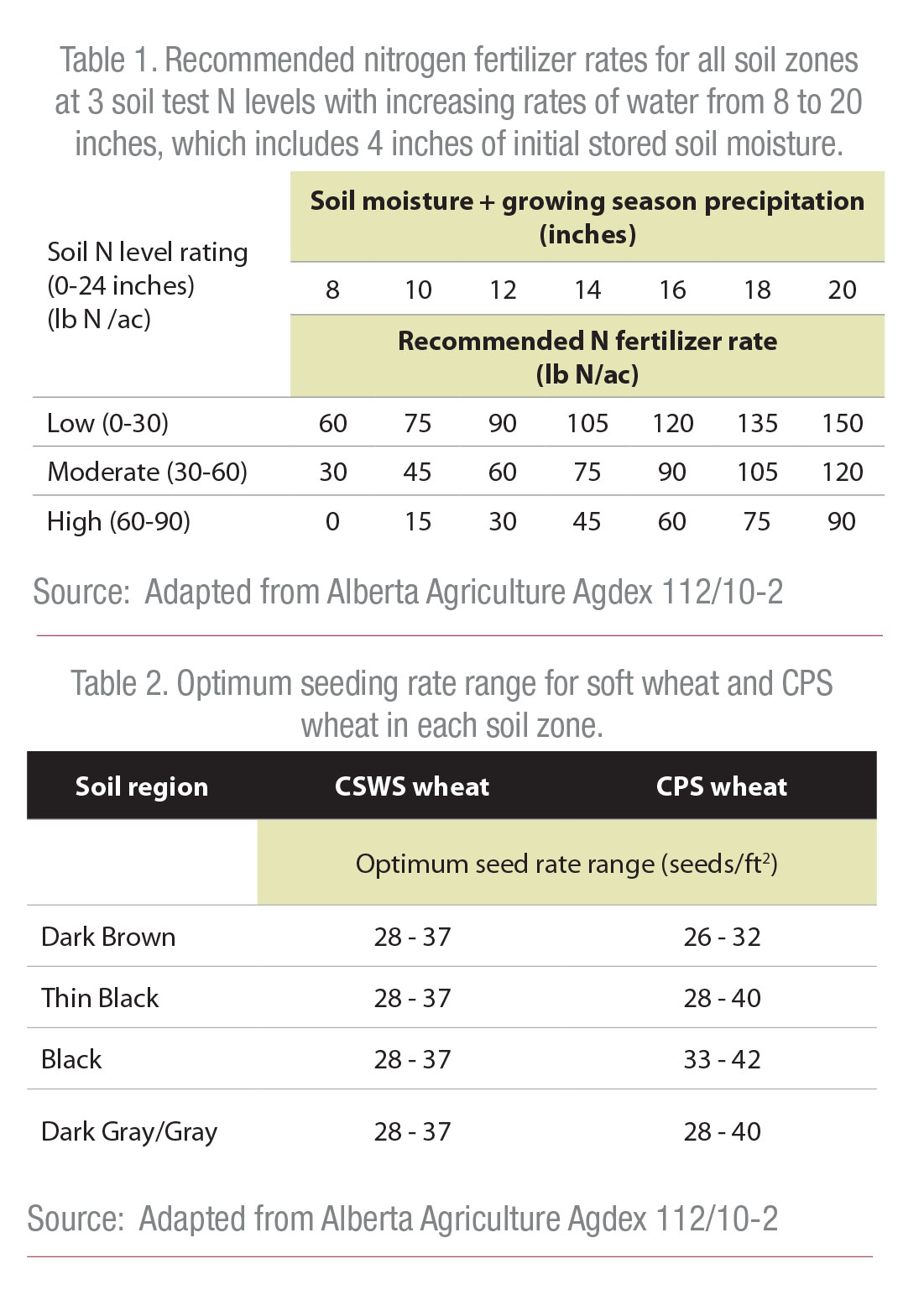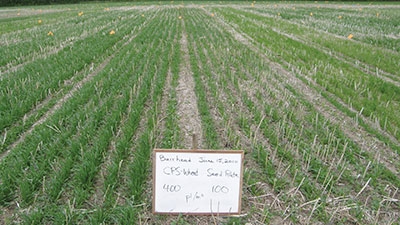
Features
Agronomy
Fertility and Nutrients
Agronomic management of soft and CPS wheat
Soft white spring wheat (SWSW) and Canadian Prairie spring wheat (CPSW) production is increasing in the Parkland regions of Western Canada in the Thin Black, Black and Dark Gray soil zones.
SWSW has been traditionally grown under irrigation in southern Alberta for end uses in pastry flour markets. In the past, production of CPSW went primarily to the Canadian Wheat Board and domestic feed markets. In recent years, production of both wheat types has increased and has gone to processing into a variety of products including ethanol. These two wheat types have excellent yield potential. Both have excellent potential for production of ethanol as they generally have the highest starch contents of the various cereal crops grown on the Canadian Prairies.
Excellent advances have been made to increase yield potential and disease resistance of SWSW and CPS wheat by Agriculture and Agri-Food Canada and prairie universities.
These wheat types can be grown successfully across the Parkland region of the Prairies with the appropriate fertilizer and agronomic management. Success with these wheat types offers producers across the Prairies the option of including a uniquely different cereal crop in their crop rotation for domestic ethanol and other markets.
Alberta Agriculture and Rural Development conducted a four-year research study with SWSW and CPSW in the Dark Brown, Thin Black, Black and Gray soil areas of Alberta to examine seeding agronomy and nitrogen fertilizer requirements. SWSW and CPS wheat were grown successfully at all locations each year, and yields were generally very good to excellent at all sites. Results showed that SWSW and CPS wheat can be grown successfully in the Prairie and Parkland region of southern and central Prairies.
Nitrogen fertilizer response
Both wheat types were very responsive to nitrogen (N) fertilizer in each soil zone, in each year. Increasing N fertilizer rates significantly increased grain yield and improved grain quality of SWSW and CPSW across all sites and years. However, the magnitude of N fertilizer response varied widely among site years depending on the soil test N level, soil organic matter content and effective growing season precipitation. Maximum grain yields were generally high.
In 2010, CPSW yield at four of five sites was at 100 bu/ac or higher, and for SWSW, was over 90 bu/ac. Generally, CPSW was slightly higher yielding than SWSW at the same locations. The unfertilized grain yields ranged from 30 to 60 bu/ac for SWSW and ranged from 40 to 70 bu/ac for CPSW, depending on the soil test N level and soil organic matter content.
The economically optimum N rate was approximately 100 lb N/ac based on the average yield response to N fertilization across all sites, but optimum rate ranged from 30 to more than 145 lb N/ac, depending on the site. Yield was strongly correlated with growing season precipitation, but was not necessarily well related to soil test N level.
From the results of this study, N fertilizer rates for SWSW and CPSW should be based on the range in expected growing season precipitation for a given location, with less emphasis on soil test N. Table 1 provides the recommended rates of N fertilizer based on the assumption of four inches (100 mm) of stored soil moisture at the time of planting plus increasing rates of precipitation at low, medium and high soil test N levels. This table can be used for estimating N fertilizer recommendations for both SWSW and CPSW.
Results showed that N fertilization increased kernel weight and protein concentration. Added N had either little effect or resulted in a very slight decline in starch concentration, but the slight decline was small compared to the considerable grain yield benefit from increased N fertilizer. Generally, CPS wheat had a slightly higher starch content than SWSW. Therefore, N fertilizer rates suitable for optimum grain production were also suitable for optimum starch production.
Optimum seeding rates
Both wheat types responded to increased seeding rates in each soil zone in each year. The average grain yield was about 15 bu/ac (17 per cent) higher at 46 seed/ft2 (500 seeds/m2) versus at 9 seed/ft2 (100 seeds/m2). Increasing the seeding rate was often beneficial to increasing grain yield.
Site years with lower growing season precipitation did not benefit from higher seeding rates, while site years with more than eight inches (200 mm) of precipitation consistently benefitted from higher seeding rates. In this study, the seeding rate for optimum yield for SWSW ranged from 28 to 37 seeds/ft2 across all soil zones. For CPS wheat, the optimum seeding rates ranged from 26 to 32 seeds/ft2 in the Dark Brown soil zone to 33 to 42 seeds/ft2 in the Black soil zone. Table 2 provides the optimum seeding rate range for SWSW and CPS wheat in each soil zone.
Protein and starch concentrations were unaffected by seeding rate, so management practices for optimum yield are also suitable for maximum starch productivity.
Summary
SWSW and CPS wheat are excellent for production in the Dark Brown, Thin Black, Black, and Dark Gray/Gray soil zones. Optimum N fertilizer rates for grain production increased with growing season precipitation, but fertilizer N response was not strongly correlated with pre-seeding soil test N levels. Significant yield benefit from increasing seeding rates were observed and were most effective when more than eight inches (200 mm) of growing season precipitation was received. But results were inconsistent at sites with less than eight inches of growing season precipitation. Starch concentrations were either unaffected or only slightly affected by seeding rate or N fertilizer rate. Agronomic practices that are optimum for SWSW and CPSW grain production were also optimum for starch production.

November 6, 2014 By Ross H. McKenzie PhD P. Ag.
 CPS wheat seeding rate treatments of 100 versus 400 seeds/sq metre on a Gray soil at Barrhead. Soft white spring wheat (SWSW) and Canadian Prairie spring wheat (CPSW) production is increasing in the Parkland regions of Western Canada.
CPS wheat seeding rate treatments of 100 versus 400 seeds/sq metre on a Gray soil at Barrhead. Soft white spring wheat (SWSW) and Canadian Prairie spring wheat (CPSW) production is increasing in the Parkland regions of Western Canada.